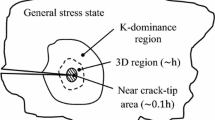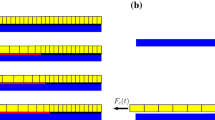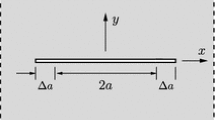Abstract
The complex stress intensity factor K governing the stress field of an interface crack tip may be split into two parts, i.e., \(\hat{K}\) and \(s^{-\mathrm{i}\varepsilon }\), so that \(K=\hat{K}s^{-\mathrm{i}\varepsilon }, s\) is a characteristic length and \(\varepsilon \) is the oscillatory index. \(\hat{K}\) has the same dimension as the classical stress intensity factor and characterizes the interface crack tip field. That means a criterion for interface cracks may be formulated directly with \(\hat{K}\), as Irwin (ASME J. Appl. Mech. 24:361–364, 1957) did in 1957 for the classical fracture mechanics. Then, for an interface crack, it is demonstrated that the quasi Mode I and Mode II tip fields can be defined and distinguished from the coupled mode tip fields. Built upon SIF-based fracture criteria for quasi Mode I and Mode II, the stress intensity factor (SIF)-based fracture criterion for mixed mode interface cracks is proposed and validated against existing experimental results.

Similar content being viewed by others
References
Irwin, G.R.: Analysis of stresses and strains near the end of a crack traversing a plate. ASME J. Appl. Mech. 24, 361–364 (1957)
Williams, M.L.: The stresses around a fault or crack in dissimilar media. Bull. Seismol. Soc. Am. 49, 199–204 (1959)
England, A.H.: A crack between dissimilar media. ASME J. Appl. Mech. 32, 400–402 (1965)
Rice, J.R., Sih, G.C.: Plane problems of cracks in dissimilar media. ASME J. Appl. Mech. 32, 418–423 (1965)
Rice, J.R.: Elastic fracture mechanics concepts for interfacial cracks. ASME J. Appl. Mech. 55, 98–103 (1988)
Suo, Z.G.: Mechanics of interface fracture. Ph.D. thesis, Harvard University (1989)
Hutchinson, J.W., Suo, Z.G.: Mixed mode cracking in layered materials. Adv. Appl. Mech. 29, 63–191 (1991)
Yuuki, R., Xu, J.Q.: Stress based criterion for an interface crack kinking out of the interface in dissimilar materials. Eng. Fract. Mech. 41, 635–644 (1992)
Yuuki, R., Liu, J.-Q., Xu, J.-Q., et al.: Mixed mode fracture criteria for an interface crack. Eng. Fract. Mech. 47, 367–377 (1994)
Cai, X.J., Xu, J.Q.: Interfacial fracture criteria based on the nominal deformation energy of interface. Int. J. Frac. Mech. 75, 16–21 (2015)
Banks-Sills, L.: Interface fracture mechanics: Theory and experiment. Int. J. Fract. 191, 131–146 (2015)
Malyshev, B.M., Salganik, R.L.: The strength of adhesive joint using the theory of crack. Int. J. Frac. Mech. 5, 114–128 (1965)
Liechti, X.M., Chai, Y.S.: Asymmetric shielding in interfacial fracture under in-plane shear. ASME J. Appl. Mech. 59, 296–304 (1992)
Rice, J.R.: A path independent integral and approximate analysis of strain concentration by notches and cracks. ASME J. Appl. Mech. 35, 379–386 (1968)
Acknowledgments
The author gratefully acknowledges the financial support of the National Natural Science Foundation of China (Grant 11572226). The author wishes to thank Professor Tianjian Lu of Xi’an Jiaotong University for helpful discussions.
Author information
Authors and Affiliations
Corresponding author
Appendices
Appendix 1
The criterion for mixed mode based on the energy release rate for an interface crack is
therefore,
Since
we have
and
Substitute Eq. (36) into Eq. (39),
then, Eq. (40) may be simplified to the criterion based on the energy release rate as follows,
Appendix 2
In addition, Liechti and Chai [13] measured the critical interface toughness with a plane strain specimen as showed in the insert of Fig. 1. The problem associated with the interface crack in this specimen has been solved analytically by Rice [14]. The solution is
where
for this specimen system, \(\omega =16^{\circ }\) and \(\varepsilon =0.06\).
The phase angle \(\psi \) is defined as
where
The phase angle \(\psi \) is given in Sect. 4 of Ref. [7], as
where
In the present paper,
and the phase angle \(\hat{\psi }\) is defined as
It follows that
Rights and permissions
About this article
Cite this article
Ji, X. SIF-based fracture criterion for interface cracks. Acta Mech. Sin. 32, 491–496 (2016). https://doi.org/10.1007/s10409-015-0551-1
Received:
Revised:
Accepted:
Published:
Issue Date:
DOI: https://doi.org/10.1007/s10409-015-0551-1




